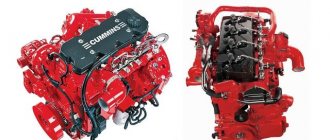RF TRUCK PARK
The total number of trucks as of January 1, 2022
is
3.78 million.
The average age of the vehicle fleet is
21.2 years
, with vehicles over
15 years old
accounting for
64.7%
of the total.
The total share of foreign representatives is about 33%
, and ownership of legal entities accounts for
52.1%
.
By type of engine used, diesel engines account for 69.5%
of the total number of trucks, with 19.8% complying with the environmental standard
Euro4
and
higher .
The leaders in terms of volume in terms of regional division of truck fleets are Moscow, which accounts for 160.3 thousand units.
, Moscow region -
155.8 thousand units.
and Krasnodar Territory with
144.2 thousand units.
100 thousand units
are registered in 5 other constituent entities of the Russian Federation trucks: Rostov region, Irkutsk region, Tatarstan, Khanty-Mansiysk Autonomous Okrug and Novosibirsk region.
Based on the breakdown of the Russian truck fleet by brand with a total share of 57%
The leaders are representatives of the domestic automobile industry:
KAMAZ
with
927.3 thousand units.
,
GAZ
with
729.8 thousand units.
and
ZIL
-
495.6 thousand units.
Among the representatives of foreign brands, the largest number of cars in the Russian Federation is
VOLVO
with
105.3 thousand units.
,
MAN
with
98.6 thousand units.
and
Scania
with
88.4 thousand units.
Detailed information is presented in Figure 1. “Truck fleet in Russia: key figures”
Rice. 1: Truck fleet in Russia: key figures
Source: Analytical agency "Avtostat".
RF BUS FLEET
For the total number of buses as of January 1, 2022.
is
409.9 thousand units.
The average age of equipment is
16.5 years
, and the share of equipment
over 15 years
accounts for
45.8%
of the total fleet.
The share of foreign representatives accounts for 25.5%
, while legal entities own
70.6%
of the total number of buses.
In terms of the type of engine used, diesel engines account for half of the fleet - 49.3%
; based on environmental standards, the share of buses that meet the
Euro-4 standard (and higher)
is
22.6%
.
Based on the division by constituent entities of the Russian Federation, the leaders are Moscow with 20.5 thousand units.
, Krasnodar region with
17.4 thousand units.
and Moscow Region with
15.9 thousand units.
10 thousand
are registered in 7 other subjects of the Russian Federation : St. Petersburg, Tatarstan, Rostov region, Irkutsk region, Krasnoyarsk region, Novosibirsk region and Sverdlovsk region.
Among the presented brands, the first three in terms of the number of registered buses with a total share of more than 66%
of the entire fleet are Russian representatives:
PAZ
-
185.7 thousand units.
,
KAvZ
-
48.9 thousand units.
and
LIAZ
with
37 thousand units.
The leaders in terms of volume among foreign brands are:
Hyundai
-
16.4 thousand units.
,
MB
-
8.9 thousand pieces.
and
Ikarus
with
8.6 thousand units.
Detailed information is presented in Figure 1. “Bus fleet in Russia: key figures”
Rice. 1: Bus fleet in Russia: key figures
Source: Analytical agency "Avtostat".
[edit] Types
[edit] Freight transport
Main article
:
Road freight transport in Russia
The main types of cargo transported by road transport in Russia (total transported 5544 million tons in 2018): construction materials, timber cargo, agricultural products, petroleum products, ferrous and non-ferrous metal ores, coal. The largest shippers of cargo (million tons, 2018): Tyumen (202, including Khanty-Mansiysk Autonomous Okrug - Yugra 128), Moscow (150), Bryansk (55), Sverdlovsk (46), Samara (40), Belgorod ( 40), Tomsk (39) regions, Krasnoyarsk (71), Krasnodar (67) territories, Tatarstan (68), Rostov region (49) and Bashkortostan (40).[1]
[edit] Passenger transport
Main article
:
Passenger road transport in Russia
Intracity traffic accounts for 82% of the total number of passengers transported by road (2017), suburban traffic - 16%, intercity (including international) traffic - 2%. The largest senders of passengers (million passengers, 2018): Moscow (1289), Moscow region (625), St. Petersburg (588), Nizhny Novgorod region (401), Bashkortostan (388), Tyumen region (306), Tatarstan (300 ), Krasnodar Territory (293), Rostov Region (285), Perm (238) and Krasnoyarsk (220) Territories, Vologda (259), Sverdlovsk (249), Kemerovo (232), Voronezh (224), Saratov (221) and Novosibirsk (208) region.[2]
TEXACO DELO ENGINE OILS FOR TRUCKS AND BUSES
TEXACO DELO motor oils have highly effective properties and provide reliable engine protection even under extreme operating conditions. You can always rely on TEXACO DELO high-performance motor oils and other Texaco brand lubricants to help you achieve lower maintenance costs and maximum performance.
TEXACO DELO products are manufactured using the latest technologies, which, combined with accumulated expert knowledge, produce lubricants that effectively protect your equipment and extend its service life, thereby helping your business become even more successful even in a highly competitive environment.
TEXACO DELO MOTOR OILS
- Guarantee of enhanced engine protection operating in harsh Russian conditions
- Engine operation during extended replacement interval
- Ensuring Fuel Economy
- Extended service life and maximum engine efficiency
[edit] Opinion polls
In February 2014, VTsIOM conducted a survey in Russia, asking the question “Does your family have a car or not?” Answers:[4]
- Yes, there is one car - 43%
- Yes, there is more than one car - 4%
- No - 53%
Answers to the question “What kind of car does your family have” (% of those who have a car in their family):[5]
- New car of a domestic brand (not older than 3 years) - 11%
- Used car of a domestic brand (over 3 years old) - 40%
- New “foreign car” (not older than 3 years) - 17%
- Used foreign car (over 3 years old) - 35%
- Difficult to answer - 2%
Operator "Platon": 67% of heavy trucks in Russia belong to individuals
The operator of Platon, RT-Invest Transport Systems, published another report on registration in the system. This time, instead of traditional data on how many carriers and vehicles joined Plato in a month, the company disclosed information about the structure of the Russian road freight market.
In its report, the Platon operator emphasizes that it was thanks to the system that “the state received actual data on the number of carriers and the structure of owners of heavy trucks.”
Thus, at the moment, of all vehicles registered in the system, 67% belong to individuals , 22% to legal entities and 11% to individual entrepreneurs.
At the same time, it is only possible to assess to what extent these data correspond to the true structure of the Russian market , since information about how many trucks are actually used for transportation, which part of those that should be in Platon has already joined the system, and which still unregistered, missing .
In total, according to the traffic police, there are about 6.5 million small and large-tonnage trucks in Russia. In the Platon system, which only covers trucks over 12 tons , there are now 1.17 million vehicles , although, according to scattered estimates, about 2 million such vehicles are used in the country.
In the domestic market, in addition, the practice of registering trucks in the name of individuals , while it is the transport ones that work with them, is quite common; at a minimum, it allows us to avoid the increased requirements that are imposed on the transport of legal entities and individual entrepreneurs.
In particular, trucks of legal entities and individual entrepreneurs must be equipped with tachographs and undergo a pre-trip technical inspection, and their drivers must observe a work and rest schedule and be “checked” by a doctor before leaving. Responsibilities for individual owners so far limited to the need to “ensure that the technical condition of vehicles complies with legal requirements” and “carry out technical maintenance of vehicles.”
Let us remind you: from November 1, 2019, the installation of a tachograph will become mandatory for trucks weighing over 3.5 tons owned by individuals. Plus, one of the latest legislative initiatives of the Ministry of Transport is to extend the work and rest regime to all truck drivers without exception . The bill, however, has not even reached the State Duma yet, but it is believed that its provisions should also come into effect by November 1 of this year.
In addition, the use of attracted drivers along with their transport, it is worth recognizing, allows you to “get rid” of part of the taxes .
At the same time, we note that Platon’s information still agrees with the approximate market estimates that industry experts previously shared. Thus, small carriers were given a share of 80% . If we add individuals to individual entrepreneurs in the Plato data, then somewhere around the same number (78%) will come out.
[edit] Indicators
[edit] Freight transportation
In 2022, cargo transportation and cargo turnover of road transport at the end of 2022 amounted to 5,447 million tons and 253.1 billion ton-km (100.3 and 102.2%, respectively, compared to 2016), commercial cargo transportation and commercial cargo turnover - 1 604.8 million tons and 133 billion t-km (101.8 and 105.9%, respectively).[6]
[edit] Passenger transportation
In 2022, 10.9 billion passengers were transported by public road transport (99.2% compared to 2016), passenger turnover amounted to 116 billion passenger-km (99.3%).[7]
Length of public roads with hard surface of federal, regional or intermunicipal importance in Russia with the movement of public passenger transport (thousand km):
- January 1, 2015: 429.7658[8]
- January 1, 2022: 426.6053[9]
Rosstat on the number of trucks
By 1991, when one country disappeared and the young Russian state rose in its place, there were 2,779 thousand trucks. As many as 60 thousand of them were in the possession of citizens.
p, blockquote 3,0,0,0,0 –>
Rice. 1. Availability of trucks, thousand units. at the end of the year
By 2010, the fleet of vehicles for cargo transportation in Russia had grown to 5.5 million units, almost doubling compared to the 1991 level. But the number of vehicles in personal ownership has changed from single copies to almost three million.
p, blockquote 4,0,0,0,0 –>
p, blockquote 5,0,0,0,0 –>
By the beginning of 2018, the truck fleet had grown by another 18.5% and exceeded the 1991 level by 2.3 times. Our fellow citizens owned 3.9 million trucks by this time.
[edit] Links
Main article
:
Links on the topic “Road transport in Russia”
[edit] Ministry of Internal Affairs of Russia
- Road traffic accidents in the Russian Federation for 2020
[edit] RZD-Partner
- Auto - Reviews
- Auto News
- Logistics - Statistics
[edit] Expert
- How to comply with traffic rules
- The organization of automobile traffic along the Rossiya highway does not yet have alternatives
- Why so expensive?
[edit] LiveJournal
- Number of deaths per 1000 cars in the Russian Federation
- Why Russia is not Italy
- The impact of zero ppm on accident rates
- Rating "Truck"
- Registration of new cars in Europe 2001—2013
- Car park of the USSR. January 1, 2015
[edit] Runet
- Information on road safety indicators[10]
- Road maintenance. Automobile transport
- Comparative analysis of the automobile markets of Russia and Ukraine. May 2012
- Where is the most dangerous place to drive: ranking of Russian regions
- Congestion and redness
- Number of deaths per 10 thousand vehicles (people)
- Russian car market: when will the gap with the United States close?[3]
- Traffic jams in Russian cities
- Foreigners get cheated on more often
- The truck changes shape. A new commercial vehicle is not a luxury, but a means to increase profits. October 29, 2013
- Popular models slow down the market
- Traffic jams in Russian cities
[edit] Other
- TRANSPORT AND CONNECTIONS OF UKRAINE 2012
- World Bank Russian Economic Report No. 28. October 2012
- Automotive market in Russia and the CIS. Industry overview. February 2012
- Automotive market in Russia and the CIS Industry overview. March 2013
- Russian economy and automobile market
Structure of the Russian truck fleet
We are able to assess the state of the truck fleet in the Russian Federation using data from the analytical agency AUTOSTAT. At the beginning of 2022, there were 3.8 million of them. In this case, medium-capacity (CV) and large-capacity (HCV) equipment are taken into account. Almost 86% of the fleet are HCV trucks.
p, blockquote 8,0,0,0,0 –>
Rice. 3. KamAZs are the most popular trucks in Russia
Over the past five years, the number of vehicles until this year remained unchanged at 3.7 million units and only on January 1, 2022 increased to 3.8 million. But the share of foreign cars in the structure of freight road transport increased significantly compared to 2010, from 10 up to 31%.
p, blockquote 9,0,0,0,0 –>
p, blockquote 10,0,0,0,0 –>
Table 1. Change in the truck fleet by brand as of the beginning of the year
p, blockquote 11,0,0,0,0 –>
| Trucks | 2010 | 2015 | 2016 | 2017 | 2018 | 2019 |
| Total, million pieces | 3,4 | 3,73 | 3,7 | 3,7 | 3,7 | 3,8 |
| IN % | ||||||
| Domestic brands: | ||||||
| KamAZ | 21,9 | 22,2 | 22,6 | 23,1 | 23,9 | 17,1 |
| GAS | 24,8 | 21,4 | 21,2 | 20,9 | 20,4 | 11,7 |
| ZIL | 19,3 | 15,7 | 15,5 | 15,0 | 14,5 | 5,6 |
| MAZ | 7,6 | 7,8 | 7,9 | 7,8 | 7,8 | 5,5 |
| Ural | 5,4 | 4,7 | 4,7 | 4,7 | 4,8 | 2,9 |
| Foreign cars: | ||||||
| Volvo | 1,6 | 2,2 | 2,3 | 2,3 | 2,5 | 2,5 |
| MAN | 1,3 | 2,1 | 2,2 | 2,2 | 2,3 | 2,4 |
| Scania | 1,1 | 1,8 | 1,8 | 1,9 | 2,0 | 2,1 |
p, blockquote 12,0,0,0,0 –>
The most popular brands of trucks invariably include those from the domestic automobile industry: KamAZ, GAZ and ZIL, although their share is constantly decreasing.
p, blockquote 13,1,0,0,0 –>
Rice. 4. Change in the share of the most popular domestic truck brands, in %
201311110808-201311110808-2_no_copyright_
As Autostat predicts, in just 2–3 years our country will be able to get ahead of Germany in the total number of cars, even with lower sales volumes of new cars. According to Frost & Sullivan estimates, in 2015–2020 the Russian car market will not exceed 3 million passenger cars per year, while in Germany approximately 3.3 million cars will be sold annually. However, unlike Germany, whose vehicle fleet is practically not growing, but is only being renewed, in our country the number of passenger cars is increasing, largely due to the slow disposal of junk cars, which will allow the Russian vehicle fleet to become the largest in Europe.
“The population of Russia is almost twice that of Germany, so the total vehicle fleet may be larger. But in terms of the number of cars per capita, we are unlikely to soon overtake the Germans. In Germany there is one car for about two residents, and in our country it is for four. However, Germany is not a European leader in this indicator,” notes Dmitry Lukashov.
Forecast for the formation of the passenger car fleet in Russia until 2022, thousand units.
According to the director of the sales department Petr Kostikov , the shares of Chevrolet and Opel that left Russia will over time be redistributed, rather, to Hyundai, Volkswagen and Kia, while the more expensive Toyota and Nissan will be in less demand.
However, Toyota and Nissan are very popular in the used car market, so the fleets of these brands in Russia will remain the largest, adds Anna Ozdelen, . In her opinion, the most dynamic growth of vehicle fleets can be expected from automakers such as Hyundai, Renault, Volkswagen, etc., which have local production in Russia, which allows them to offer a diverse range of models with competent price positioning.
Age structure of the passenger car fleet in Europe
It is worth noting that the Russian fleet of cars of foreign brands is quite young, which is primarily due to the growing demand for them, which arose in the early 2000s. If foreign cars produced before 2005 account for 32%, then the share of cars aged from 5 to 10 years is 29%. And most of all cars are under 5 years old - almost 39%, which is largely due to the entry of budget foreign cars into the market in recent years.
According to Peter Kostikov, to rejuvenate the entire Russian vehicle fleet, it is necessary to lower car loan rates, allocate more subsidies for automakers, reduce the cost of gasoline, insurance and, of course, improve the quality of roads. “In general, even despite the crisis, Russians will buy cars, but will look for more affordable options,” he sums up.
New truck market
Sales of new trucks throughout 2022, despite all the known difficulties, developed relatively steadily. According to Autostat Info, during the first quarter, sales were at 5,857 units in January, 5,513 chassis in February and 5,295 cars in March. During the “lockdown” period, the truck market did not shrink much: after a decline in sales in April (4,599 units), sales volume increased to 5,041 vehicles in May and to 6,273 units in June.
In the third quarter, sales figures remained at relatively high levels: 6,273 vehicles in July, 5,844 chassis in August and 6,900 units in September.
At the end of the year, sales of new trucks increased even more. Thus, in October, 7,202 units of equipment were sold, in November a slight decline was recorded - to 6,690 cars, and in December sales increased to 9,139 cars.
In total, 72,683 new trucks were sold in Russia in 2022, Autostat Info analysts report. This is 7.8% less than what was sold in 2022 - 78,807 units.
Over the past year, foreign-made trucks in the country dropped by 15.5% from 34,957 to 29,556 chassis, and sales of domestic vehicles fell by 1.6% from 43,850 to 43,127 units. The shares between these segments in total sales were distributed as 40.7% and 59.3%, respectively.
The December results prove that the foreign car segment is the hardest hit. Since sales of such trucks decreased by 17% by December 2022, that is, from 4,702 to 3,901 vehicles, and their share decreased to 42.7%. For comparison, in the same period, 5,238 new Russian trucks were sold, 1.7% less than in December 2019 (5,326 chassis), which corresponds to a share of 57.3%.
The leader in the truck market is KAMAZ. The Russian auto giant sold 28,207 units of equipment during the year, which almost corresponds to the result for 2022 (27,887 vehicles).
The second place, with a large gap from the sales leader, is occupied by GAZ - 7,995 cars sold, which is 18% less than in 2022 (9,727 units).
Third place in the overall ranking of the cargo market and first place among foreign cars is occupied by Scania - 4,831 trucks sold, 12% less than in 2022 (5,472 chassis).
Volvo came fourth in the annual ranking with 3,722 vehicles, indicating a 33% decline in sales compared to sales in 2022 (5,565 units). MAN closes the top 5 with a sales figure of 3,605 trucks, which is 20% less than what was sold in the entire year 2022 (4,497 units).
The top 5 best-selling models of the truck market in 2022 were, according to Avtostat Info, KAMAZ-43118 - 6472 chassis sold (-5%), GAZon NEXT - 6384 units (-3%), " KAMAZ-5490" - 5532 vehicles (+7%), "KAMAZ-65115" - 5490 vehicles (-7%) and "KAMAZ-6520" - 3556 units (+21%).
The Central Federal District market remains the largest market for new trucks in the country. During the year, 22,863 chassis were sold here, 11% less than in 2022 (25,794 units). At the same time, in the Volga region, the market volume of new trucks decreased by 7% from 16,428 to 15,261 vehicles. In the Urals, 9,511 trucks were sold during the year. This is 2% less than a year earlier (9,719 units), and on the market of the Siberian Federal District there are 8,547 cars, the same as in 2022 (8,522 cars).
Consumers in the Northwestern District market bought 6,602 trucks over the year, 18% less than in 2022 (8,002 chassis), and buyers in the Southern region market bought 4,322 vehicles, 8% less than in the previous year (4 705 units). In the North Caucasus, the cargo market decreased by 11% from 1,688 to 1,498 units, and in the Far East it grew by 3% from 3,949 to 4,079 units.









